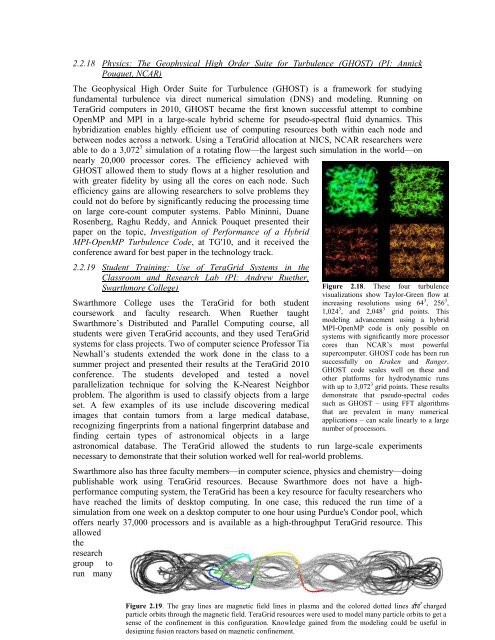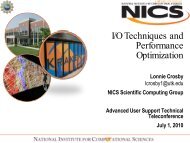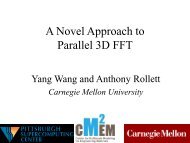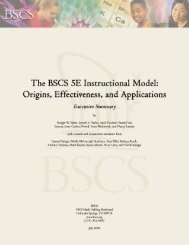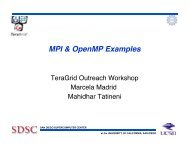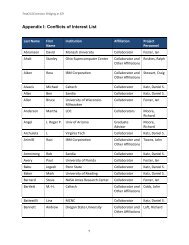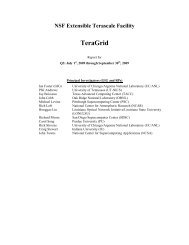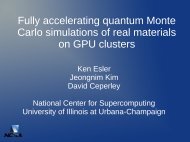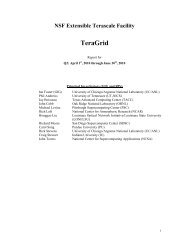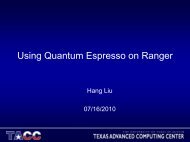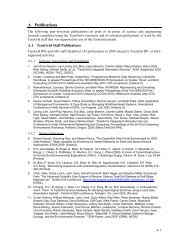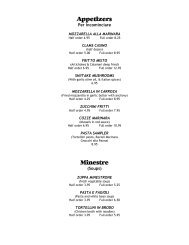TGQR 2010Q4 Report.pdf - Teragridforum.org
TGQR 2010Q4 Report.pdf - Teragridforum.org
TGQR 2010Q4 Report.pdf - Teragridforum.org
Create successful ePaper yourself
Turn your PDF publications into a flip-book with our unique Google optimized e-Paper software.
2.2.18<br />
Physics: The Geophysical High Order Suite for Turbulence (GHOST) (PI: Annick<br />
Pouquet, NCAR)<br />
The Geophysical High Order Suite for Turbulence (GHOST) is a framework for studying<br />
fundamental turbulence via direct numerical simulation (DNS) and modeling. Running on<br />
TeraGrid computers in 2010, GHOST became the first known successful attempt to combine<br />
OpenMP and MPI in a large-scale hybrid scheme for pseudo-spectral fluid dynamics. This<br />
hybridization enables highly efficient use of computing resources both within each node and<br />
between nodes across a network. Using a TeraGrid allocation at NICS, NCAR researchers were<br />
able to do a 3,072 3 simulation of a rotating flow—the largest such simulation in the world—on<br />
nearly 20,000 processor cores. The efficiency achieved with<br />
GHOST allowed them to study flows at a higher resolution and<br />
with greater fidelity by using all the cores on each node. Such<br />
efficiency gains are allowing researchers to solve problems they<br />
could not do before by significantly reducing the processing time<br />
on large core-count computer systems. Pablo Mininni, Duane<br />
Rosenberg, Raghu Reddy, and Annick Pouquet presented their<br />
paper on the topic, Investigation of Performance of a Hybrid<br />
MPI-OpenMP Turbulence Code, at TG'10, and it received the<br />
conference award for best paper in the technology track.<br />
2.2.19<br />
Student Training: Use of TeraGrid Systems in the<br />
Classroom and Research Lab (PI: Andrew Ruether,<br />
Swarthmore College)<br />
Swarthmore College uses the TeraGrid for both student<br />
coursework and faculty research. When Ruether taught<br />
Swarthmore’s Distributed and Parallel Computing course, all<br />
students were given TeraGrid accounts, and they used TeraGrid<br />
systems for class projects. Two of computer science Professor Tia<br />
Newhall’s students extended the work done in the class to a<br />
summer project and presented their results at the TeraGrid 2010<br />
conference. The students developed and tested a novel<br />
parallelization technique for solving the K-Nearest Neighbor<br />
problem. The algorithm is used to classify objects from a large<br />
set. A few examples of its use include discovering medical<br />
images that contain tumors from a large medical database,<br />
recognizing fingerprints from a national fingerprint database and<br />
finding certain types of astronomical objects in a large<br />
Figure 2.18. These four turbulence<br />
visualizations show Taylor-Green flow at<br />
increasing resolutions using 64 3 , 256 3 ,<br />
1,024 3 , and 2,048 3 grid points. This<br />
modeling advancement using a hybrid<br />
MPI-OpenMP code is only possible on<br />
systems with significantly more processor<br />
cores than NCAR’s most powerful<br />
supercomputer. GHOST code has been run<br />
successfully on Kraken and Ranger.<br />
GHOST code scales well on these and<br />
other platforms for hydrodynamic runs<br />
with up to 3,072 3 grid points. These results<br />
demonstrate that pseudo-spectral codes<br />
such as GHOST – using FFT algorithms<br />
that are prevalent in many numerical<br />
applications – can scale linearly to a large<br />
number of processors.<br />
astronomical database. The TeraGrid allowed the students to run large-scale experiments<br />
necessary to demonstrate that their solution worked well for real-world problems.<br />
Swarthmore also has three faculty members—in computer science, physics and chemistry—doing<br />
publishable work using TeraGrid resources. Because Swarthmore does not have a highperformance<br />
computing system, the TeraGrid has been a key resource for faculty researchers who<br />
have reached the limits of desktop computing. In one case, this reduced the run time of a<br />
simulation from one week on a desktop computer to one hour using Purdue's Condor pool, which<br />
offers nearly 37,000 processors and is available as a high-throughput TeraGrid resource. This<br />
allowed<br />
the<br />
research<br />
group to<br />
run many<br />
Figure 2.19. The gray lines are magnetic field lines in plasma and the colored dotted lines are charged<br />
particle orbits through the magnetic field. TeraGrid resources were used to model many particle orbits to get a<br />
sense of the confinement in this configuration. Knowledge gained from the modeling could be useful in<br />
designing fusion reactors based on magnetic confinement.<br />
25


